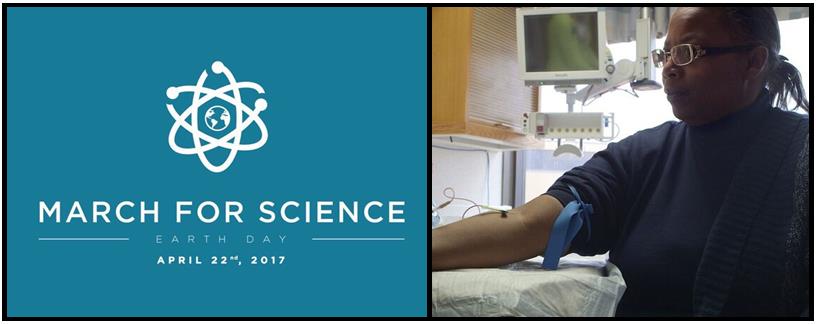Scientific progress can be long in human years. With each generation, young scientists stand on the shoulders of giants. Many never see the full impact of their work. Scientific research is a pay-it-forward endeavor.
The March for Science, coming worldwide April 22, is significant because for the first time, many folks who may prefer to “let the evidence speak” will be holding picket signs and raising their voices. With the slogan, “Science, not Silence,” the organizers assert that the scientific process must be safeguarded – shouted, not muzzled.
The March for Science, a self-described diverse non-partisan group, seeks to, “envision and sustain an unbroken chain of inquiry, knowledge, and public benefit for all.”
“Science is first and foremost a human process — it is conducted, applied, and supported by a diverse body of people. Scientific inquiry is not an abstract process that happens independent of culture and community. It is an enterprise carried out by people who seek to expand our knowledge of the world in the hope of building a better, more informed society.”[1]
This important movement is a battle cry to safeguard science. It sounds a necessary alarm about the fragility of science and the need for people to publicly and bravely fight for its existence.
The urgency to safeguard scientific research is especially evident in longitudinal studies that are making progress to reverse clear death spirals—for example, the way many family history studies are figuring out how to stop Alzheimer’s disease. The WRAP study has an unbroken chain of data from over 1,500 subjects since the year 2001. The study tracks biological and cognitive changes in people at high risk of Alzheimer’s disease as they age. It has taken time and diligence to gather objective data. The evidence about what may either trigger or delay—or even prevent the disease’s onset is starting to come to light. It is imperative that this study is supported until the cohort has gone through the natural aging process and is conclusive. The WRAP study is just one of thousands of studies across many disciplines making progress toward life-sustaining answers.
This is worth fighting for.
But that’s only part of the fabric.
Another durable form of activism is mostly anonymous, but just as brave. It’s found in the steadfast actions of people who “walk the walk” daily, often against convenience. The repeated habits and conscientious choices of many people working toward a common goal weave a powerful force.
This is true of many endeavors, but one place where the ball cannot be dropped is in science.
In the world of medical research, human subjects are perhaps the most invisible of all. Each person is a number – anonymous! Some are in the test group, some in the control group, some taking the trial drug, some the placebo. They donate their time, donate their flesh, expose themselves to uncomfortable procedures. But through their efforts and energy, they provide data and evidence.
Nothing is more powerful and preciously-won than good data—in a society that values the scientific process. It may even be subverted for a period of time, but nothing beats the evidence.
Science is evidence-based inquiry that leads to discoveries. We need the strongest possible American scientific community on task and sharp to keep up with big problems that are both predictable and unexpected.
This month we celebrate the activists – those who shout and those who give spinal fluid. All hands on deck.
–Melissa Godoy, Director
[1] March for Science, last modified March 9, 2017, https://www.marchforscience.com
